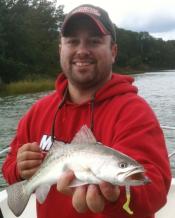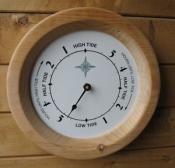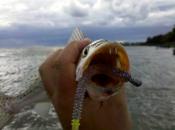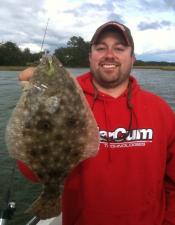 “We can do better.” More a personal philosophy than it is a motto to me, I’m always looking for a way to improve upon fishing successes, even when generally satisfied with the luck we’ve been having. Last year for my first trip out east to fish the Chesapeake, I detailed some of our trials and tribulations in targeting a variety of fish species with live bait, peeler blue crab to be exact. With a year of that type of “new” fishing under my belt, I came into the game much more prepared this time. Not just to do better at what I had already learned, but more importantly, to impart some new wrinkles to the approach. I’m a tinkerer when it comes to all things fishing and hunting, and this would be no different. Before heading out, I cruised the message boards out Virginia-way to find that folks had seen some positive results in using jig/plastic combinations for our intended species, the speckled trout. There seemed to be a strong preference towards shad-style baits, particularly the Storm WildEye pre-rigged baits, for fishing both sea trout and stripers. Others still had used grub-style plastics with lighter jig heads in the tidal creeks we typically fished. Either way, it was apparent that the approach at least had some validity, and I could cast with confidence in the fact that there’s not a predatory freshwater fish that swims which won’t eat jigs and plastics. Why not saltwater fish?
“We can do better.” More a personal philosophy than it is a motto to me, I’m always looking for a way to improve upon fishing successes, even when generally satisfied with the luck we’ve been having. Last year for my first trip out east to fish the Chesapeake, I detailed some of our trials and tribulations in targeting a variety of fish species with live bait, peeler blue crab to be exact. With a year of that type of “new” fishing under my belt, I came into the game much more prepared this time. Not just to do better at what I had already learned, but more importantly, to impart some new wrinkles to the approach. I’m a tinkerer when it comes to all things fishing and hunting, and this would be no different. Before heading out, I cruised the message boards out Virginia-way to find that folks had seen some positive results in using jig/plastic combinations for our intended species, the speckled trout. There seemed to be a strong preference towards shad-style baits, particularly the Storm WildEye pre-rigged baits, for fishing both sea trout and stripers. Others still had used grub-style plastics with lighter jig heads in the tidal creeks we typically fished. Either way, it was apparent that the approach at least had some validity, and I could cast with confidence in the fact that there’s not a predatory freshwater fish that swims which won’t eat jigs and plastics. Why not saltwater fish?
 The plot thickens as you start to think about the influences of the tide, and how it drives the entire fishery. Fishery, heck, your night and day…….your trip! Breakfast, lunch, and dinner? They take backseat to the way high tide progressively moves one-hour later each and every day. Sonar? Only moderately useful for this kind of fishing. Reading water seams, ebb-tide flow out of “guts” and “necks,” and the way tidal flow moves your bait are the premium. A wrist-watch? The only true way a fisherman tells time out on the coast is a tide-clock. After all, your fish aren’t going to move up and eat until the flow-tide or ebb-tide washes food around for them. And when the tide turns, you’d better have everything ready at the tips of your fingers, because it’s some of the fastest fishing you’ll ever be lucky enough to experience. Tide is the number one variable that drove our fishing, and it’s also to me, a Midwestern boy with little salt-water experience, the most mysterious one. Tides are caused by gravitational pull at the earth by both the moon and the sun, with the moon being the primary force. For the dates of our trip, being between a new moon and the first quarter, the moon was nearly directly in-line between the sun and the earth. It’s at this time that the tidal forces are greatest, and the tide’s range is at its maximum. This “spring-tide” has nothing to do with the season, and everything to do with the springing motion, higher tides, and faster flushes we were seeing, as evidenced by the boat parking lots being about ankle deep with water when trying to launch. Flow tide lasts for a few hours, and is most intense just before the slack water high tide period. The ebb tide, about a half hour after the slack water period, is the next period we focused on for up to an hour after high tide.
The plot thickens as you start to think about the influences of the tide, and how it drives the entire fishery. Fishery, heck, your night and day…….your trip! Breakfast, lunch, and dinner? They take backseat to the way high tide progressively moves one-hour later each and every day. Sonar? Only moderately useful for this kind of fishing. Reading water seams, ebb-tide flow out of “guts” and “necks,” and the way tidal flow moves your bait are the premium. A wrist-watch? The only true way a fisherman tells time out on the coast is a tide-clock. After all, your fish aren’t going to move up and eat until the flow-tide or ebb-tide washes food around for them. And when the tide turns, you’d better have everything ready at the tips of your fingers, because it’s some of the fastest fishing you’ll ever be lucky enough to experience. Tide is the number one variable that drove our fishing, and it’s also to me, a Midwestern boy with little salt-water experience, the most mysterious one. Tides are caused by gravitational pull at the earth by both the moon and the sun, with the moon being the primary force. For the dates of our trip, being between a new moon and the first quarter, the moon was nearly directly in-line between the sun and the earth. It’s at this time that the tidal forces are greatest, and the tide’s range is at its maximum. This “spring-tide” has nothing to do with the season, and everything to do with the springing motion, higher tides, and faster flushes we were seeing, as evidenced by the boat parking lots being about ankle deep with water when trying to launch. Flow tide lasts for a few hours, and is most intense just before the slack water high tide period. The ebb tide, about a half hour after the slack water period, is the next period we focused on for up to an hour after high tide.
 Searching then becomes difficult when your primary tactics are most efficient only when tide-water is running – either filling, or emptying the small fingers and tidal creeks we were fishing. Is there something wrong with our presentation, our location, our boat positioning? To make matters more difficult, sea trout are notorious for being spooky to boat noise and crowding. The good news is that we entered into the game with some knowledge on locations from last year. Small “guts” inside of these tidal creeks were simply tiny freshwater feeders that had their own “deltas” where the mouth of each gut met the main creek channel. Here, there was typically a large shallow shelf, which fanned out at the mouth, and saw a fairly abrupt break into the larger channel. Most of our trout came from this ledge, where they sat on top to ambush prey swept into it from the channel during flood tide, and at the bottom of the ledge to catch bait being swept out of the gut during ebb tide. Typically, we fished the flow-tide period for about an hour before slack water, catching most of our fish just before the water went slack. Then, the wind calms and the water stays high, signifying the slack water period which saw only a small bit of action. One half hour later, the water starts running back out, and the fishing gets pretty intense when you can see current and seams setting up, along with jellyfish, bait, snags, and pine needles that are pushed back out to sea.
Searching then becomes difficult when your primary tactics are most efficient only when tide-water is running – either filling, or emptying the small fingers and tidal creeks we were fishing. Is there something wrong with our presentation, our location, our boat positioning? To make matters more difficult, sea trout are notorious for being spooky to boat noise and crowding. The good news is that we entered into the game with some knowledge on locations from last year. Small “guts” inside of these tidal creeks were simply tiny freshwater feeders that had their own “deltas” where the mouth of each gut met the main creek channel. Here, there was typically a large shallow shelf, which fanned out at the mouth, and saw a fairly abrupt break into the larger channel. Most of our trout came from this ledge, where they sat on top to ambush prey swept into it from the channel during flood tide, and at the bottom of the ledge to catch bait being swept out of the gut during ebb tide. Typically, we fished the flow-tide period for about an hour before slack water, catching most of our fish just before the water went slack. Then, the wind calms and the water stays high, signifying the slack water period which saw only a small bit of action. One half hour later, the water starts running back out, and the fishing gets pretty intense when you can see current and seams setting up, along with jellyfish, bait, snags, and pine needles that are pushed back out to sea.
 As for presentation, this year, I boarded the plane armed and dangerous. My ammo? A pile of stickbaits, and an even bigger selection of H2O Precision Jigs and B’Fishin’ Plastics. Super-Dos and K-Grubs in various colors all caught fish, but far and away the biggest winner was a 3/32 oz. Precision Jig Unpainted with a Ringworm in Firecracker Chart. Tail. This sounds like Pool 4 talk I know, and the coolest part of this pattern was the fact that many of the same reasons it worked on the river, and the techniques used in pitching, lended themselves here. Aiding my introduction to this technique in the bay, was the fact that speckled trout hit a jig and plastic WAY harder than your average walleye. Don’t get me wrong, a walleye on a mission in shallow water sure puts a thump on those jigs, but these fish hit them on the run! One look down their gullet at those sharp vampire fangs, tells you all you need to know about how voracious they both act and look. As with walleye fishing, matching the jig-size (fall rate) to the conditions was critical. However, the tides moved so fast at times that a 3/8oz jig was required to keep you in the zone, let alone to combat the bad winds we fished in day-in, day-out. 18-20mph winds kept us up in the creeks, but even there, fishing a small jig was not an easy task. As for the eats, amidst buckets of clams, oysters, crab, shrimp, and scallops, the trout were in an eating class all their own. Picture the flake and shape of a walleye fillet, with the fat content of salmon in a white meat that had a buttery flavor. The best part about it, was that this type of fishing is truly attainable on your own via a boat rental or some other way to get you into one of the hundreds of tidal creeks up and down the Chesapeake. We also saw several sea kayaks rigged for fishing, even a jet-ski rigged to fish. I had a blast, and learned far too much to ever share within the confines of a report, but I know a few things. Saltwater fishing is addictive. Seafood out there is about as good as it gets. I’ll be bringing more ringworms next year!
As for presentation, this year, I boarded the plane armed and dangerous. My ammo? A pile of stickbaits, and an even bigger selection of H2O Precision Jigs and B’Fishin’ Plastics. Super-Dos and K-Grubs in various colors all caught fish, but far and away the biggest winner was a 3/32 oz. Precision Jig Unpainted with a Ringworm in Firecracker Chart. Tail. This sounds like Pool 4 talk I know, and the coolest part of this pattern was the fact that many of the same reasons it worked on the river, and the techniques used in pitching, lended themselves here. Aiding my introduction to this technique in the bay, was the fact that speckled trout hit a jig and plastic WAY harder than your average walleye. Don’t get me wrong, a walleye on a mission in shallow water sure puts a thump on those jigs, but these fish hit them on the run! One look down their gullet at those sharp vampire fangs, tells you all you need to know about how voracious they both act and look. As with walleye fishing, matching the jig-size (fall rate) to the conditions was critical. However, the tides moved so fast at times that a 3/8oz jig was required to keep you in the zone, let alone to combat the bad winds we fished in day-in, day-out. 18-20mph winds kept us up in the creeks, but even there, fishing a small jig was not an easy task. As for the eats, amidst buckets of clams, oysters, crab, shrimp, and scallops, the trout were in an eating class all their own. Picture the flake and shape of a walleye fillet, with the fat content of salmon in a white meat that had a buttery flavor. The best part about it, was that this type of fishing is truly attainable on your own via a boat rental or some other way to get you into one of the hundreds of tidal creeks up and down the Chesapeake. We also saw several sea kayaks rigged for fishing, even a jet-ski rigged to fish. I had a blast, and learned far too much to ever share within the confines of a report, but I know a few things. Saltwater fishing is addictive. Seafood out there is about as good as it gets. I’ll be bringing more ringworms next year!
Joel
Here’s some more pics!
Joel
Crab and Newcastle!? Forget about fishing at that point, I would stay near those eats!
Sounds like it was a fun and productive trip. Did you guys keep the flounder? They are delicious.
Crab is pretty much my favorite, and we binge when we’re out there. Crab cakes for breakfast with eggs, Crab cake sandwiches for lunch, even a crab quesadilla at a local Mexican restaurant. My favorite had to be from a small joint on the water, that was shrimp and scallop scampi in a bread bowl, smothered in she-crab soup. Unbelievable.
As for the flounder, they’re well-protected in the bay, and we messed up a bit on that one. Previous regulations were a 19.5″ minimum, and we had heard they’d be increasing the minimum size limit from there. We never measured it, but I’d guess it almost 20″es or so. Only later did we come to find out that the minimum size was actually decreased to 17.5″, which that fish was over. Bummer! Crab stuffed flounder is a popular dish out there.
Joel
Awesome fish buddy! those trout sure are fun. sounds like you had a great time!
Awesome fish buddy! those trout sure are fun. sounds like you had a great time!
Very cool report Joel!
Only problem is your making me hungry.
Sure wouldn’t mind trying a few of the seafood items on that menu right about now.
Spec’s are fun, that was a great read
That big pile of crab shells left me with a grumbling stomach.
So Joel,
How does a guy get set up for a trip like this ?
Any contacts ?
Thank You Very Much for sharing your outing with us !!
Dave:
I wish I could be more helpful, but I fish with my boss out of his dad’s boat which is permanently out there. A guide would get you in the game more quickly, but because of the diverse fishing opportunities out there, I’d be very specific with him about what you’re looking for. There’s everything from tuna and sharks off-shore, to gray trout and flounder in the near-shore oceanside creeks, to specs, stripers, and many others in the bay-side creeks. That said, this is truly a deal where you could rent a boat, and with some reasonable boating/fishing skills expect to do well in a few days of fishing once you put in some time finding them. The biggest thing is to not beach your boat in shallow water on a falling tide. You’ll be there about 12 hours until the tide rises and lifts you off again.
Our biggest spec was about 19″, and most were 12-15″, which isn’t setting any records. I know down Texas way I’ve heard there’s some great speckled trout fishing for larger fish, but I also have heard that the bigger fish move in the Chesapeake towards later October/November.
Anyone who’s interested can shoot me a PM and I’ll do my best to steer them in the right direction.
Joel
Thanks Joel !!!
Great tips for a far away excursion !!
Ahh, shallow water, jig & plastics, specs, reds and others, tides and great eating seafood…. It really doesn’t get any better than that on any of the seacoasts!!!
As much as I would like to try some offshore reef/wreck fishing, fishing shallow is sooo much fun!!! For those that like to go during the winter when southern temps can be marginal, why would you want to go out where 60* water makes you cold, waves/swells make you seasick, when you can stay close to shore, stay warm, forget the dramamine, get bit a lot, and fish with walleye equipment to battle fish that can’t jump and take 50 yards of line off your reel and then do it again.
Great read Joel, and sometime would like to fish the blues in the surf and stripers just outside the bay and eat more of that fresh crab!!!
Mark
Very unique report, Joel. Thanks for sharing!
Way cool Joel

A trip like that peaks my interest a lot more than thinking of heading South. It looks like you were living the dream for a few days